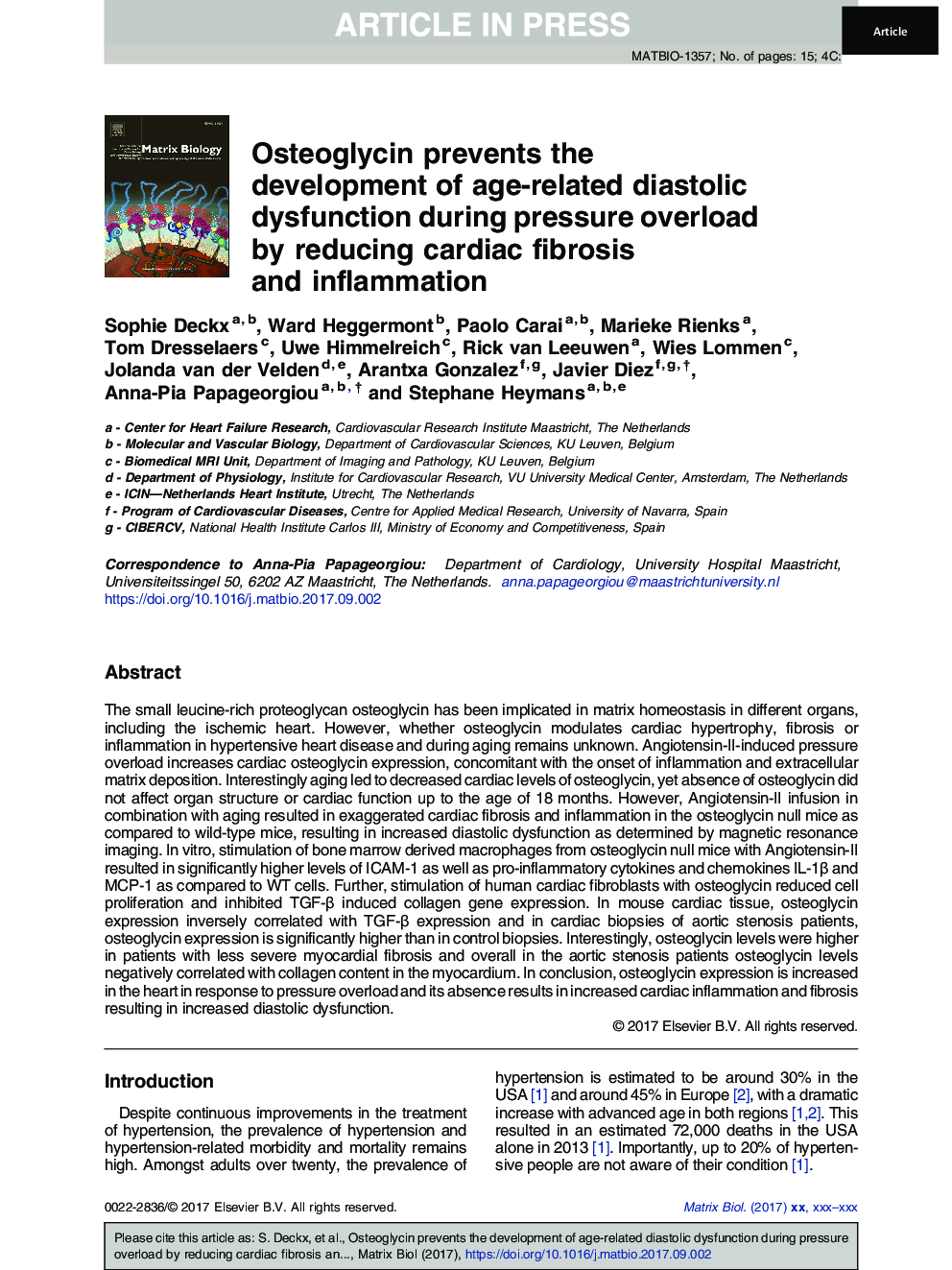| کد مقاله | کد نشریه | سال انتشار | مقاله انگلیسی | نسخه تمام متن |
|---|---|---|---|---|
| 8455082 | 1547996 | 2018 | 15 صفحه PDF | دانلود رایگان |
عنوان انگلیسی مقاله ISI
Osteoglycin prevents the development of age-related diastolic dysfunction during pressure overload by reducing cardiac fibrosis and inflammation
ترجمه فارسی عنوان
استئوگلیسین جلوگیری از اختلال عملکرد دیاستولیک مرتبط با سن در هنگام اضافه بار با کاهش فیبروز قلبی و التهاب
دانلود مقاله + سفارش ترجمه
دانلود مقاله ISI انگلیسی
رایگان برای ایرانیان
کلمات کلیدی
فشار خون، سالخورده، اختلال عملکرد دیاستولیک، ماتریکس، فیبریزه، استئوگلیسین،
موضوعات مرتبط
علوم زیستی و بیوفناوری
بیوشیمی، ژنتیک و زیست شناسی مولکولی
تحقیقات سرطان
چکیده انگلیسی
The small leucine-rich proteoglycan osteoglycin has been implicated in matrix homeostasis in different organs, including the ischemic heart. However, whether osteoglycin modulates cardiac hypertrophy, fibrosis or inflammation in hypertensive heart disease and during aging remains unknown. Angiotensin-II-induced pressure overload increases cardiac osteoglycin expression, concomitant with the onset of inflammation and extracellular matrix deposition. Interestingly aging led to decreased cardiac levels of osteoglycin, yet absence of osteoglycin did not affect organ structure or cardiac function up to the age of 18 months. However, Angiotensin-II infusion in combination with aging resulted in exaggerated cardiac fibrosis and inflammation in the osteoglycin null mice as compared to wild-type mice, resulting in increased diastolic dysfunction as determined by magnetic resonance imaging. In vitro, stimulation of bone marrow derived macrophages from osteoglycin null mice with Angiotensin-II resulted in significantly higher levels of ICAM-1 as well as pro-inflammatory cytokines and chemokines IL-1β and MCP-1 as compared to WT cells. Further, stimulation of human cardiac fibroblasts with osteoglycin reduced cell proliferation and inhibited TGF-β induced collagen gene expression. In mouse cardiac tissue, osteoglycin expression inversely correlated with TGF-β expression and in cardiac biopsies of aortic stenosis patients, osteoglycin expression is significantly higher than in control biopsies. Interestingly, osteoglycin levels were higher in patients with less severe myocardial fibrosis and overall in the aortic stenosis patients osteoglycin levels negatively correlated with collagen content in the myocardium. In conclusion, osteoglycin expression is increased in the heart in response to pressure overload and its absence results in increased cardiac inflammation and fibrosis resulting in increased diastolic dysfunction.
ناشر
Database: Elsevier - ScienceDirect (ساینس دایرکت)
Journal: Matrix Biology - Volume 66, March 2018, Pages 110-124
Journal: Matrix Biology - Volume 66, March 2018, Pages 110-124
نویسندگان
Sophie Deckx, Ward Heggermont, Paolo Carai, Marieke Rienks, Tom Dresselaers, Uwe Himmelreich, Rick van Leeuwen, Wies Lommen, Jolanda van der Velden, Arantxa Gonzalez, Javier Diez, Anna-Pia Papageorgiou, Stephane Heymans,
